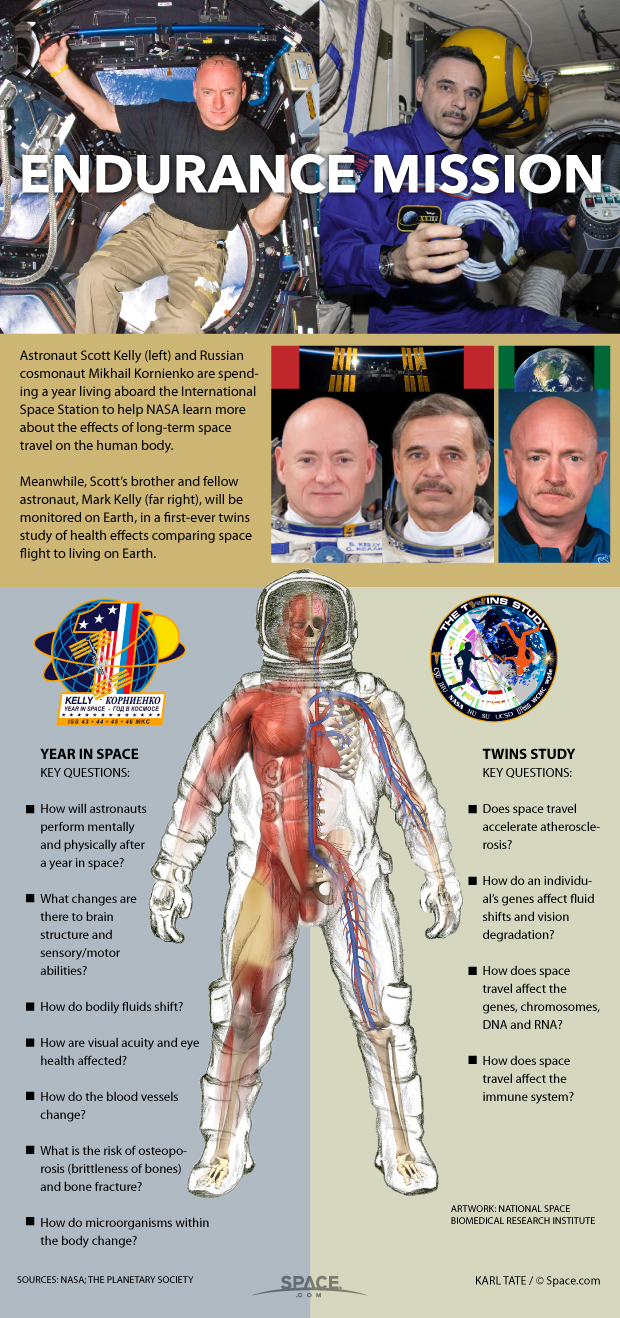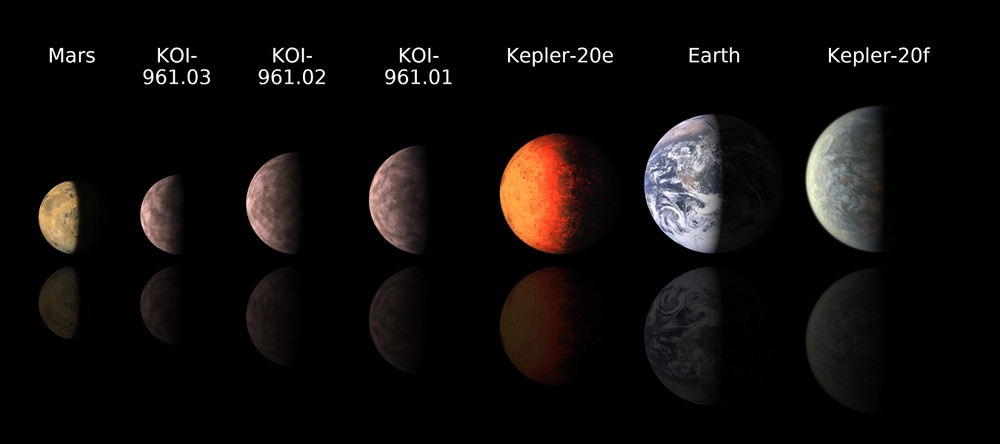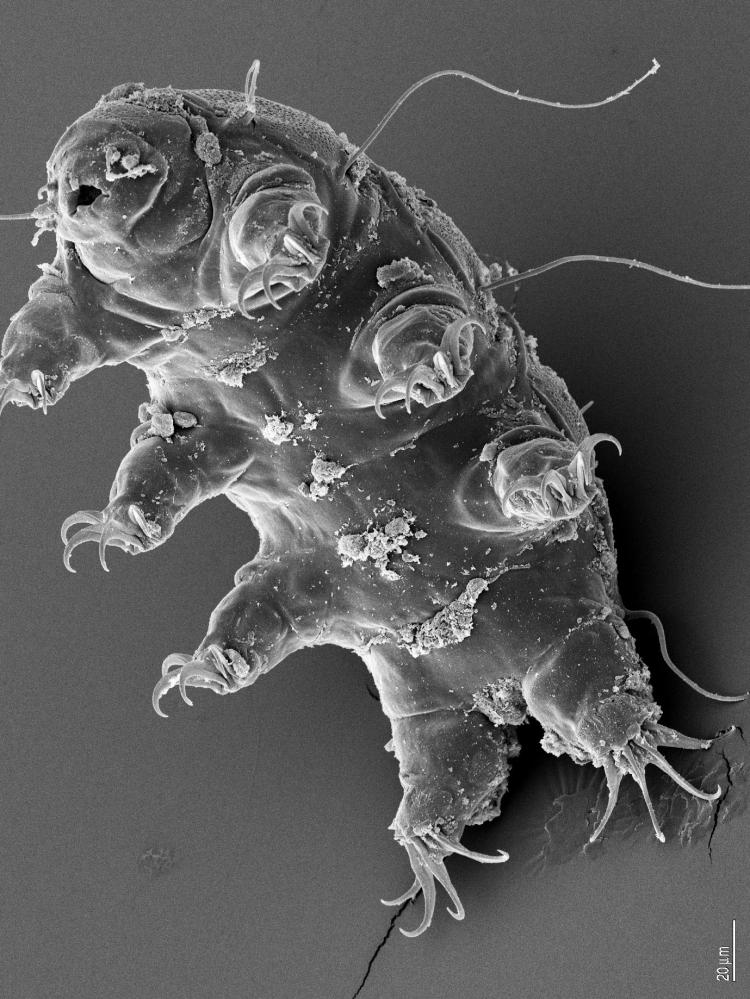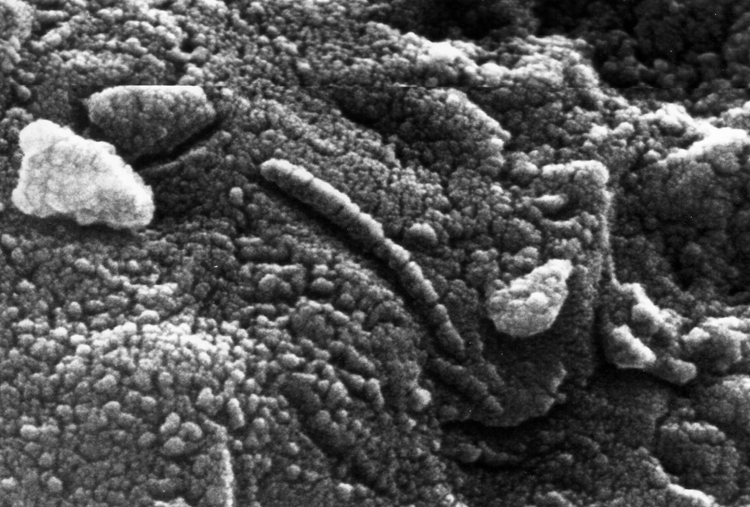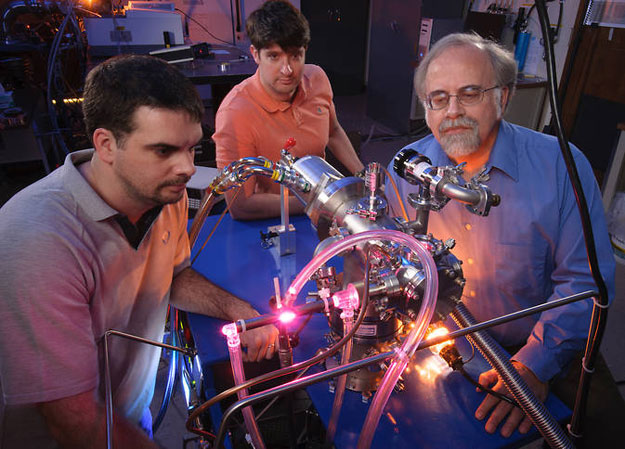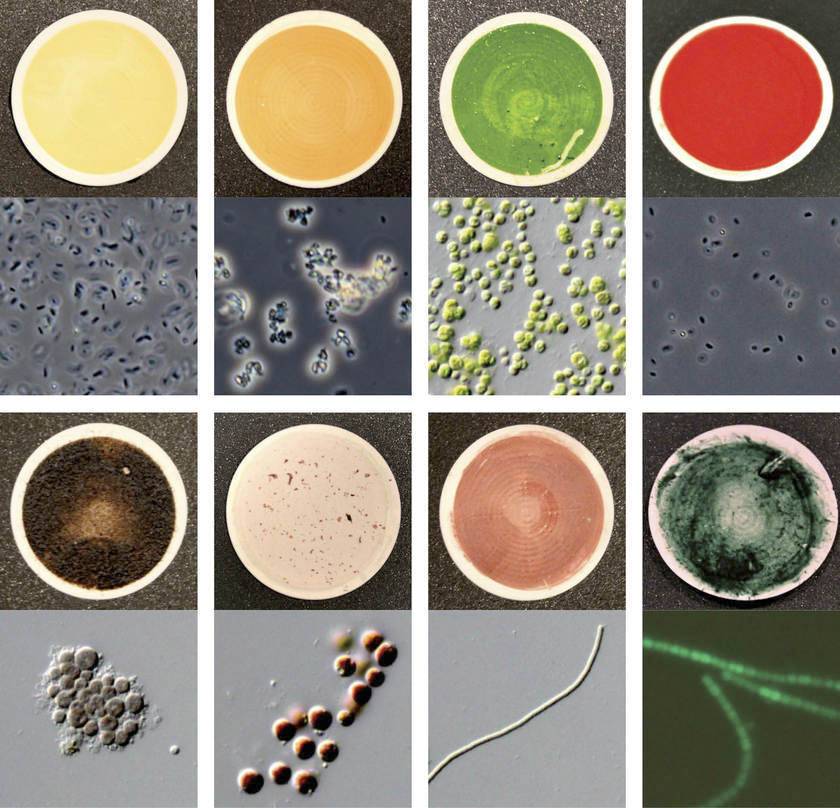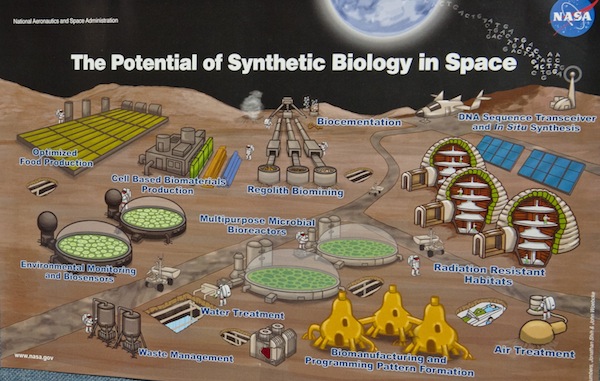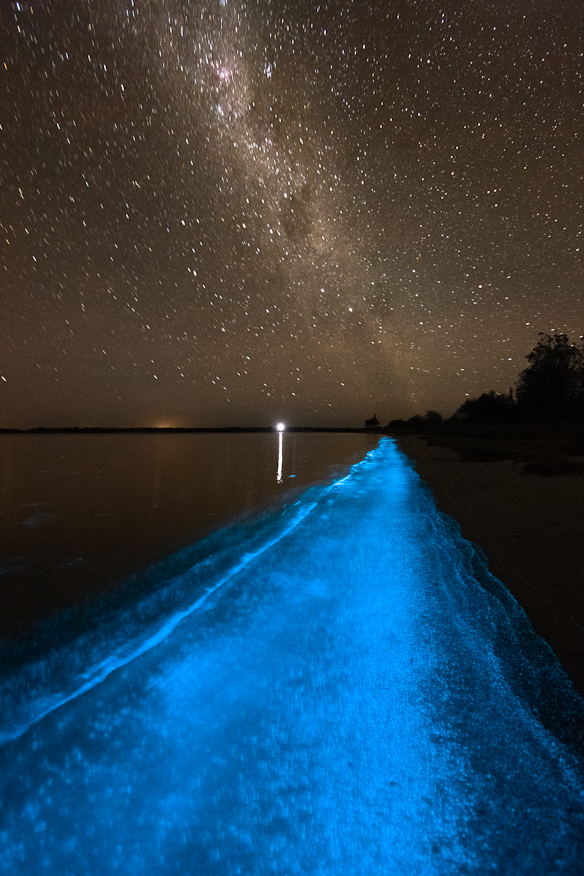ASTROBIOLOGY PICTURE OF THE WEEK
#APOW published on: June 1, 2016

A living thecate foraminiferan, with a plump cell body and numerous thread-like pseudopods (extensions) that it uses to capture prey and explore its surroundings. Thecate foraminifera produce a soft, organic sheath around themselves.
Credit: Photo by Joan Bernhard, Woods Hole Oceanographic Institution
ASTROBIOLOGY PICTURE OF THE WEEK
#APOW published on: May 09, 2016

Stromatolites, once widespread in coastal areas, now thrive in just a few locations in the tropical Atlantic and Indian Oceans and in some very salty lakes. The formations seen here are near Shark Bay on the western coast of Australia. The cyanobacteria in stromatolites live very near the surface of the rock, where they can receive the sunlight they need to photosynthesize.
Credit: Photo by Virginia Edgcomb, Woods Hole Oceanographic Institution
ASTROBIOLOGY PICTURE OF THE WEEK
#APOW published on: April 11, 2016

Wrinkle mats at the Dresser Formation (Pilbara region).
Credit: Wikicommons
ASTROBIOLOGY PICTURE OF THE WEEK
#APOW published on: April 4, 2016

Lake stromatolites
Credit: Nora Noffke
ASTROBIOLOGY PICTURE OF THE WEEK
#APOW published on: Mar 14, 2016

Erosional remnants and pockets, a microbial mat-induced sedimentary surface relief typical for sandy tidal flats. The elevated erosional remnants are biostabilized by sediment-trapping microbial mats; the deeper erosional pockets were caused by erosion and by constant reworking of the bottom sediments so that microbial mats cannot establish. Example from Mellum Island, North Sea, 1994.
Credit: Nora Noffke
ASTROBIOLOGY PICTURE OF THE WEEK
#APOW published on: Mar 3, 2016

An example of structures from the Dresser Formation, Pilbara, Western Australia, plus possible modern equivalents.
Credit: Noffke et al. 2013.
ASTROBIOLOGY PICTURE OF THE WEEK
#APOW published on: Feb 25, 2016

Elongate nested stromatolites, previously unknown in Hamelin Pool
Credit: Pamela Reid, Ph.D., UM Rosenstiel School of Marine and Atmospheric Science
ASTROBIOLOGY PICTURE OF THE WEEK
#APOW published on: Feb 18, 2016

Details of the Eokinorhynchus rarus fossil, only a few millimeters in length, can be seen in this electron microscopic image. More than 530 million years old, the ancient worm was found in South China by researchers associated with Virginia Tech and is closely related to the ancestor of modern animal phylum kinorhyncha.
Credit: Virginia Tech
ASTROBIOLOGY PICTURE OF THE WEEK
#APOW published on: Feb 8, 2016

The image shows a droplet of condensed nano-DNA and within it smaller drops of its liquid crystal phase which show up in polarized light on the left. The liquid crystal droplets act as ‘micro-reactors’.
Credit: Noel Clark, University of Colorado
Read More […]
ASTROBIOLOGY PICTURE OF THE WEEK
#APOW published on: Feb 1, 2016

A general diagram of the biogeochemical cycling of sulfur on Earth.
Credit: Carnegie Mellon
ASTROBIOLOGY PICTURE OF THE WEEK
#APOW published on: January 18, 2016

Environmental distribution of dsrAB diversity. This figure from Muller et al (2014) shows the classification of 7695 dsrAB sequences. A wealth of micro-organisms play a role in the cycle of sulfur on Earth, a process that is important in maintaining the habitability of Earth.
Credit: Müller et al. (2014)
ASTROBIOLOGY PICTURE OF THE WEEK
#APOW published on: January 11, 2016

Shrimp called Rimicaris hybisae crawl on the Von Damm Spire, located 7,500 feet (2,300 meters) underwater in the Caribbean. The shrimp live in symbiosis with bacteria. This fascinating ecosystem gives scientists insights into what kind of life could thrive in extreme environments elsewhere, such as Jupiter’s moon Europa.
Credit: Courtesy Chris German, WHOI/NSF, NASA/ROV Jason © 2012 Woods Hole Oceanographic Institution
ASTROBIOLOGY PICTURE OF THE WEEK
#APOW published on: January 4, 2016

Shrimp called Rimicaris hybisae at deep hydrothermal vents in the Caribbean seem to have different dietary habits depending on the proximity of other shrimp. Those who live in dense clusters like this one live off bacteria primarily, but in areas where the shrimp are distributed more sparsely, the shrimp are more likely to turn carnivorous, and even eat each other.
Credit: Courtesy Chris German, WHOI/NSF, NASA/ROV Jason ©2012 Woods Hole Oceanographic Institution
ASTROBIOLOGY PICTURE OF THE WEEK
#APOW Published on: December 7, 2015
Diagram of the iron cycle and its involvement in heavy metal immobilization.
Credit: USGS
ASTROBIOLOGY PICTURE OF THE WEEK
#APOW Published on: November 24, 2015
Oxidation is the removal of one or more electrons from a substrate. Protons (H+) are often removed with the electrons. Reduction of a substrate refers to its gain of one or more electrons. Each time a substance is oxidized, another is simultaneously reduced.
Credit: Midlands Technical College
ASTROBIOLOGY PICTURE OF THE WEEK
#APOW Published on: November 16, 2015
A rusting surface. Iron oxidizers play an important role in cycling iron on Earth and contribute to the corrosion of metal objects like bridges and pipes. Image
Credit: Laitr Keiows, Wikimedia Common
ASTROBIOLOGY PICTURE OF THE WEEK
#APOW Published on: November 2, 2015
This artist’s impression shows a sunset seen from the super-Earth Gliese 667 C. The brightest star in the sky is the red dwarf Gliese 667 C, which is part of a triple star system. The other two more distant stars, Gliese 667 A and B appear in the sky also to the right. Astronomers have estimated that there are tens of billions of such rocky worlds orbiting faint red dwarf stars in the Milky Way alone.
Credit: ESO/L. Calçada
ASTROBIOLOGY PICTURE OF THE WEEK
#APOW Published on: October 27, 2015
A moss species, called hairless twisted moss, growing as part of a biological soil crust in Utah. The member species of biological soil crusts each play important roles in maintaining the health of the overall community.
Credit: NPS/Neal Herbert
ASTROBIOLOGY PICTURE OF THE WEEK
#APOW Published on: October 19, 2015
A Bacillus species with evident flagella, the whiplike tails many microbes use to move around. All have genes for making structures such as flagella —whiplike tails — to allow them to get closer to areas with favorable nutrient availability – See more at: http://www.astrobio.net/topic/origins/extreme-life/barren-deserts-can-host-complex-ecosystems-soils/#sthash.0fkjqllw.sUNPFZtr.dpuf
Credit: CDC/Dr. William A. Clark/Wikipedia
ASTROBIOLOGY PICTURE OF THE WEEK
#APOW Published on: October 12, 2015
Ice algae have a fantastic ability to grow with very little light. Even under several meters of sea ice, mats of ice algae are formed.
Photo: Lars Chresten Lund Hansen
ASTROBIOLOGY PICTURE OF THE WEEK
#APOW Published on: October 5, 2015
The Utopia Planitia region on Mars as seen by the Viking 2 lander. Although life on Mars’ surface today is very unlikely, it could persist miles below the Red Planet’s surface.
Credit: The Viking Project, M. Dale-Bannister WU StL, NASA
ASTROBIOLOGY PICTURE OF THE WEEK
#APOW Published on: September 28, 2015
These dark, narrow, 100-meter-long streaks called recurring slope lineae flowing downhill on Mars are inferred to have been formed by contemporary flowing water. Recently, planetary scientists detected hydrated salts on these slopes at Hale crater, corroborating their original hypothesis that the streaks are indeed formed by liquid water. The blue color seen upslope of the dark streaks are thought not to be related to their formation, but instead are from the presence of the mineral pyroxene.
Credit: NASA/JPL/University of Arizona
Read More […] | More about the image: http://www.jpl.nasa.gov/spaceimages/details.php?id=PIA19916
ASTROBIOLOGY PICTURE OF THE WEEK
#APOW Published on: September 21, 2015
A beach outcrop at Davis Head on Lopez Island in Washington State, where researchers at Yale discovered veins of aragonite containing oddly light carbon isotopes suggestive of life’s imprint.
Credit: Stoddard et al
ASTROBIOLOGY PICTURE OF THE WEEK
#APOW Published on: September 14, 2015
A helicopter flies the AEM sensor over Blood Falls and the Taylor Glacier in Antarctica.
Credit: L. Jansan/astrobio.net
ASTROBIOLOGY PICTURE OF THE WEEK
#APOW Published on: September 9, 2015
Methane bubbles rising from the seafloor.
Credit: NOAA-OER/BOEM/USGS
ASTROBIOLOGY PICTURE OF THE WEEK
#APOW Published on: August 31, 2015
Artist’s conception of water vapor plume erupting from the icy surface of Europa, a moon of Jupiter, based on data from the Hubble Space Telescope.
Credit: NASA/ESA/K. Retherford/SWRI
ASTROBIOLOGY PICTURE OF THE WEEK
#APOW Published on: August 25, 2015
Recent results from NASA’s Cassini mission suggest Enceladus might have hydrothermal activity at the bottom of its subsurface ocean, as depicted in this artist’s cutaway view rendering.
Credit: NASA/JPL-Caltech
ASTROBIOLOGY PICTURE OF THE WEEK
#APOW Published on: August 18, 2015
A diagram of a hydrothermal vent with typical chemicals and geology.
Credit: Wikipedia
ASTROBIOLOGY PICTURE OF THE WEEK
#APOW Published on: August 10, 2015
A view of a hydrothermal vent at the Main Endeavor Field on the Juan de Fuca Ridge, snapped from the submersible Alvin.
Credit: Woods Hole Oceanographic Institution
ASTROBIOLOGY PICTURE OF THE WEEK
#APOW Published on: August 3, 2015
Biological soil crust in Hovenweep National Monument, a region located in southwestern Colorado and southeastern Utah.
Credit: National parks (Transferred by Nihonjoe)/Wikipedia/astrobio.net
ASTROBIOLOGY PICTURE OF THE WEEK
#APOW Published on: July 29, 2015
An image from NASA’s Mars Curiosity rover shows the Amargosa Valley on the slopes leading up to Mount Sharp. The outcroppings bear some visible resemblance to Earth’s Mojave desert.
Credit: NASA/JPL-Caltech/MSSS
ASTROBIOLOGY PICTURE OF THE WEEK
#APOW Published on: July 20, 2015
Beautiful hydrothermal chimneys in the Pescadero Basin are composed of light colored carbonate minerals. Chimneys in most other deep-sea areas are composed of dark-colored sulfide minerals.
Credit: Monterey Bay Aquarium Research Institute (MBARI), 2015
ASTROBIOLOGY PICTURE OF THE WEEK
#APOW Published on: July 15, 2015
Delicate carbonate spires were formed when scalding hot water emerged from sediments in the Pescadero Basin and came in contact with near-freezing seawater. Dense colonies of tubeworms grow on the sides of the spires. This group of spires is about five meters (15 feet) wide.
Credit: Monterey Bay Aquarium Research Institute (MBARI), 2015
ASTROBIOLOGY PICTURE OF THE WEEK
#APOW Published on: July 6, 2015
Impact crater located SW of Huygens crater, imaged by Mars Color Camera (MCC)
Image of impact crater located SW of Huygens crater, taken by Mars Color Camera (MCC) on May 4th, 2015 at a spatial resolution of 30 m from an altitude of 576 km. Complex impact crater, superimposed over pre-existing crater is clearly seen in this image. This impact crater is having average diameter of 35 km. Terraces of complex impact crater and craters of small diameter distributed in this image are also seen.
Credit: ISRO
ASTROBIOLOGY PICTURE OF THE WEEK
#APOW Published on: June 29, 2015
NASA’s InSight lander, set to launch in 2016, will include a drill to search below the surface. Read more […]
Credit: NASA
ASTROBIOLOGY PICTURE OF THE WEEK
#APOW Published on: June 22, 2015
NASA’s Curiosity rover is among those machines that have discovered signs of ancient water on Mars.
Credit: NASA/JPL-Caltech/Univ. of Arizona
ASTROBIOLOGY PICTURE OF THE WEEK
#APOW Published on: June 15, 2015
The illustration shows the habitable zone for different types of stars. The distance to the habitable zone is dependent on how big and bright the star is. The green area is the habitable zone (HZ), where liquid water can exist on a planet’s surface. The red area is too hot for liquid water on the planetary surface and the blue area is too cold for liquid water on the planetary surface.
Credit: : Niels Bohr Institute
ASTROBIOLOGY PICTURE OF THE WEEK
#APOW Published on: June 8, 2015
The Murchison meteorite is named after Murchison, Victoria, in Australia. It is one of the most studied meteorites due to its large mass (>100 kg), the fact that it was an observed fall, and that it belongs to a group of meteorites rich in organic compounds.
Credit: Wikimedia Commons
Read more | Related Research Article
ASTROBIOLOGY PICTURE OF THE WEEK
#APOW Published on: June 1, 2015
Ultraviolet radiation can damage DNA molecules, causing “rungs” in its ladder-like internal structure to improperly bond with each other.
Credit: NASA’s Earth Observatory/David Herring
ASTROBIOLOGY PICTURE OF THE WEEK
#APOW Published on: May 26, 2015
NASA astronaut Mark Kelly and Russian cosmonaut Mikhail Kornienko are taking the ultimate space trip:
one year in space on the International Space Station.
Credit: By Karl Tate, Infographics Artist
ASTROBIOLOGY PICTURE OF THE WEEK
#APOW Published on: May 18, 2015
This chart compares the smallest known exoplanets, or planets orbiting outside the solar system, to our own planets Mars and Earth.
Credit: NASA/JPL-Caltech
#APOW Published on: May 11, 2015
At various times in Earth’s history, our planet has been a “snowball”. The Snowball Earth hypothesis posits that the Earth’s surface became entirely or nearly entirely frozen at least once, sometime earlier than 650 mya (million years ago). Proponents of the hypothesis argue that it best explains sedimentary deposits generally regarded as of glacial origin at tropical paleo-latitudes, and other otherwise enigmatic features in the geological record.
Credit: MIT/WIKI
ASTROBIOLOGY PICTURE OF THE WEEK
#APOW Published on: May 4, 2015
Tardigrades (also known as waterbears or moss piglets) are water-dwelling, segmented micro-animals, with eight legs. They were first discovered by the German pastor Johann August Ephraim Goezein 1773. The name Tardigrada (meaning “slow stepper”) was given three years later by the Italian biologist Lazzaro Spallanzani. Since 1778, over 1,150 tardigrade species have been identified. Less than 1mm in length, they can withstand harsh environments and still thrive.
Credit: ESA/Dr. Ralph O. Schill
ASTROBIOLOGY PICTURE OF THE WEEK
#APOW Published on: April 27, 2015
The famous Martian meteorite ALH 84001 contains a “fossil” that was ruled out as life because of its small size;
however, it could still be an autocell — a precursor to life.
Credit: NASA
ASTROBIOLOGY PICTURE OF THE WEEK
#APOW Published on: April 20, 2015
Ames scientists Michel Nuevo, Christopher Materese and Scott Sandford reproduce uracil, cytosine, and thymine, three key components of our hereditary material, in the laboratory.
Source: NASA
Read the full story: http://astrobiology.com/2015/03/reproducing-the-building-blocks-of-life-in-laboratory.html
ASTROBIOLOGY PICTURE OF THE WEEK
#APOW Published on: April 13, 2015
An extremophile bacterium identified by NASA astrobiologist Dr. Richard Hoover, after retrieval from ice dating back 32,000 years.
What is an extremophile?
Source: http://oceanservice.noaa.gov/facts/extremophile.html
Extremophiles are organisms with the ability to thrive in extreme environments such as hydrothermal vents.
Since they live in extreme environments (under high pressure and temperature), they can tell us under which range of conditions life is possible.
The unique enzymes used by these organisms, called “extremozymes,” enable these organisms to function in such forbidding environments. These creatures hold great promise for genetically based medications and industrial chemicals and processes
It’s important to note that these organisms are ‘extreme’ only from a human perspective. While oxygen, for example, is a necessity for life as we know it, some organisms flourish in environments with no oxygen at all.
ASTROBIOLOGY PICTURE OF THE WEEK
#APOW Published on: April 6, 2015
Samples of the way different microorganisms reflect sunlight, also known as their spectra, which could help astronomers decipher what kind of life lives on planets outside our solar system. In each panel, the top is a regular photograph of the sample and the bottom is a a 400x zoomed-in version of the top image. The microorganisms here include species from a range of environments, from the Sonoran desert in Arizona to the Kamori Channel in Palau.
Credit: NASA
ASTROBIOLOGY PICTURE OF THE WEEK
#APOW Published on: March 30, 2015
A rock bed at the Gillespie Lake outcrop on Mars displays potential signs of ancient microbial sedimentary structures.
Credit: NASA
ASTROBIOLOGY PICTURE OF THE WEEK
#APOW Published on: March 23, 2015
Synthetic Biology in Space
Source: http://blogs.scientificamerican.com/oscillator/2012/03/31/foods-in-the-year-2000/
ASTROBIOLOGY PICTURE OF THE WEEK
#APOW Published on: March 16, 2015
Martian Rock ‘Harrison’ in Color, Showing Crystals
Credit: NASA/JPL-Caltech/LANL/CNES/IRAP/LPGNantes/CNRS/IAS/MSSS
ASTROBIOLOGY PICTURE OF THE WEEK
#APOW Published on: March 9, 2015
Pseudomonas aeruginosa, a bacterium grown onboard the space shuttle Atlantis, forms in a “column-and-canopy” structure unlike the arrangements observed in bacteria grown on Earth.
Credit: NASA
Read Complete Article: http://www.space.com/21886-space-bacteria-grows-strange-ways.html
#APOW Published on: March 2, 2015
Bioluminescence in the Gippsland Lakes
Bioluminescence is the production and emission of light by a living organism. It is a form of chemiluminescence. Bioluminescence occurs widely in marine vertebrates and invertebrates, as well as in some fungi, microorganisms including some bioluminescent bacteria and terrestrial invertebrates such as fireflies.
Credit: Bioluminescence Astrophotograph by Phil Hart
#APOW Published on: Feb 23, 2015
Welcome to Planet Earth, the third planet from a star named the Sun. The Earth is shaped like a sphere and composed mostly of rock. Over 70 percent of the Earth’s surface is water. The planet has a relatively thin atmosphere composed mostly of nitrogen and oxygen. With its abundance of liquid water, Earth supports a large variety of life forms, including potentially intelligent species such as dolphins and humans. Please enjoy your stay on Planet Earth.
This picture of Earth, dubbed Blue Marble, was taken from Apollo 17 in 1972 and features Africa and Antarctica. It is thought to be one of the most widely distributed photographs of any kind.
Image Credit: Apollo 17 Crew, NASA
#APOW Published on: Feb 3, 2015
Mars Orbiter Spacecraft captures its first image of Mars. Taken from a height of 7300 kilometers, with 376m spatial resolution.
IMAGE CREDIT: ISRO – Indian Space Research Organization
Contributed by:
 Benu Atri
Benu Atri
Baylor College of Medicine,
Houston, Texas, USA


























